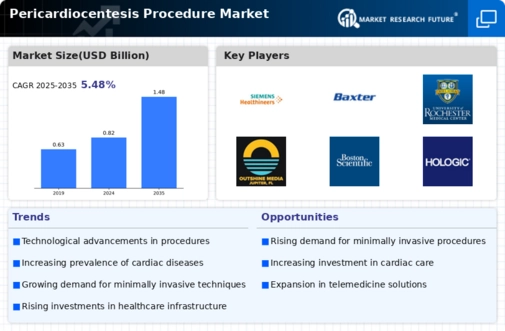Growing Geriatric Population
The aging population is a significant factor influencing the Pericardiocentesis Procedure Market. As individuals age, they are more susceptible to various health issues, including cardiovascular diseases. The geriatric demographic often presents with multiple comorbidities, increasing the likelihood of conditions that necessitate pericardiocentesis. Data indicates that the elderly population is projected to grow substantially in the coming years, leading to a higher demand for cardiac interventions. Healthcare systems are thus compelled to adapt to this demographic shift by enhancing their capabilities in managing cardiac conditions. This trend not only drives the demand for pericardiocentesis but also encourages the development of specialized training programs for healthcare professionals to ensure optimal patient care.
Rising Healthcare Expenditure
The increase in healthcare expenditure is a crucial driver for the Pericardiocentesis Procedure Market. As countries allocate more resources to healthcare, there is a corresponding rise in the availability and accessibility of advanced medical procedures. This trend is particularly evident in regions where healthcare budgets are expanding, allowing for the adoption of innovative treatments like pericardiocentesis. Enhanced funding enables hospitals to invest in the necessary equipment and training for healthcare professionals, thereby improving the overall quality of care. Furthermore, as patients become more aware of available treatment options, they are more likely to seek out procedures that can effectively address their cardiac issues. This growing demand, fueled by increased healthcare spending, is likely to propel the market for pericardiocentesis in the foreseeable future.
Rising Incidence of Cardiac Diseases
The increasing prevalence of cardiac diseases is a primary driver for the Pericardiocentesis Procedure Market. As heart-related ailments become more common, the demand for effective treatment options rises. According to recent data, cardiovascular diseases account for a significant percentage of global mortality rates, prompting healthcare providers to seek interventions like pericardiocentesis. This procedure is particularly vital for patients experiencing cardiac tamponade, a condition that can arise from various underlying issues, including malignancies and infections. The growing patient population necessitates a corresponding increase in procedural interventions, thereby expanding the market for pericardiocentesis. Furthermore, advancements in diagnostic imaging techniques have improved the identification of patients who may benefit from this procedure, further driving market growth.
Technological Innovations in Medical Devices
Technological advancements in medical devices are transforming the Pericardiocentesis Procedure Market. Innovations such as ultrasound-guided techniques and improved catheter designs enhance the safety and efficacy of the procedure. These advancements not only reduce the risk of complications but also improve patient outcomes, making pericardiocentesis a more attractive option for healthcare providers. The integration of real-time imaging during the procedure allows for greater precision, which is crucial in managing patients with complex cardiac conditions. As hospitals and clinics adopt these new technologies, the market is likely to experience significant growth. Moreover, the development of portable ultrasound devices may facilitate the procedure in emergency settings, further expanding its application and market reach.
Increased Focus on Minimally Invasive Procedures
There is a growing trend towards minimally invasive procedures within the Pericardiocentesis Procedure Market. Patients and healthcare providers alike are increasingly favoring techniques that minimize recovery time and reduce the risk of complications. Pericardiocentesis, being a less invasive alternative to surgical interventions, aligns well with this trend. The procedure allows for the drainage of excess fluid from the pericardial space without the need for open-heart surgery, which can be associated with longer recovery periods and higher risks. As awareness of the benefits of minimally invasive techniques spreads, more healthcare facilities are likely to incorporate pericardiocentesis into their treatment protocols, thereby expanding its market presence. This shift is expected to be supported by ongoing research and development aimed at improving procedural techniques and patient outcomes.


















Leave a Comment